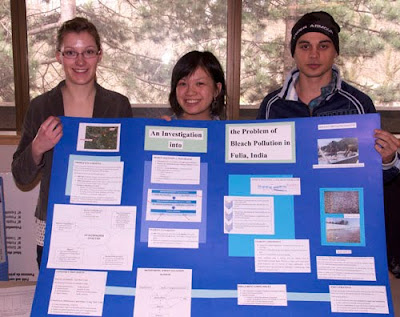Bright young minds solve problems ...
 In our previous post "Collaborating with UBC Engineers" we outlined three problems that would benefit from the type of specialized knowledge that engineering and applied science students were developing. The first involved improvements to a bellmaker's kiln, while the second and third involved small scale textile processes which presently produce a disconcerting level of toxic waste.
In our previous post "Collaborating with UBC Engineers" we outlined three problems that would benefit from the type of specialized knowledge that engineering and applied science students were developing. The first involved improvements to a bellmaker's kiln, while the second and third involved small scale textile processes which presently produce a disconcerting level of toxic waste.
We joined the students for their poster presentation and were deeply encouraged by their optimism. This was the second time we had met them. During our first meeting we outlined the problems with video and photographs and answered their questions. In neither meeting did we get the feeling that these problems were unsolvable. From the student's perspective it seemed that at least one and possibly many solutions existed, it was just a matter of finding them.
Often the students were thrown a curve ball by the projects they were working on. A student specializing in structural or electrical engineering suddenly had to know all about chemical processes right down to the street price of a certain substance in Bengal, India. That's a steep learning path. The students had only four weeks between our presentation of the problems and their presentation of some solutions.
Another aspect of the solutions was the modesty of the working budget and the requirement that solutions needed to be maintained without specialist knowledge, parts, or skills. Materials that were close at hand were preferable. These restrictions were offset by some of India's natural resources. Solar power is abundant making distillation schemes attractive methods of treating some of the toxic effluents. Human labour is also plentiful and so construction costs are reasonable. Moreover, the general attitude embraces recycling and people would rather treat the effluent to recover a substance that could be sold than allow it to run away.
All of the poster presentations were impressive. We had two main reactions as we toured the room and the students explained their approach to us. 1) How did you think of that? 2) Let's take this to India right away and try it out!
Here are some of the students standing before their poster presentation. 
L to R: Youliang Mitchell Cheong, Maryam Kashi, Shasha Wang worked on the problem of toxic waste from chemical dyes used in Sanganer, India. They proposed an ingenious distillation set-up.
L to R: Julie Laws, J. Van, and Gleb Ganeline presented a solution to the problem of bleachworks on the banks of rivers in Bengal, India. 
L to R: Jaskaranjit Singh, (Charllotte Kwon or the Maiwa Foundation) Harshul Srivastava, and Tony Lei presented kiln improvements and heating options using biogas for the bellmakers. This group made a long distance call and talked to KMVS director Punkaj Shah to get additional, on the ground information about the bellmakers and their community.
In one of our next posts we will introduce you to the people behind the course and give some background on how it got started and where it is going.
Comments are welcome.









0 comments
We moderate comments to keep posts on-topic, avoid spam, and inappropriate language. Comments should appear within 24 hours.